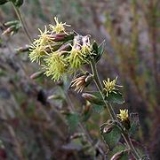
Brickellia californica
Encyclopedia
Brickellia californica is a species of flowering plant in the daisy family
known by the common name California brickellbush. It is native to western North America from Baja California
to Idaho
to Oklahoma
. It is a common plant in many habitat types, especially in dry areas.
This is a thickly branching shrub
growing one half to two meters in height. The fuzzy, glandular leaves are roughly triangular in shape with toothed to serrated edges. The leaves are 1 to 6 centimeters long. The inflorescence
s at the end of stem branches contain many small leaves and bunches of narrow, cylindrical flower heads
. Each head is about 13 millimeters long and wrapped in flat, wide, purplish green overlapping phyllaries
. At the tip of the head are a number of long white to pink disc florets. The fruit is a hairy cylindrical achene
3 millimeters long with a pappus
of bristles.
Asteraceae
The Asteraceae or Compositae , is an exceedingly large and widespread family of vascular plants. The group has more than 22,750 currently accepted species, spread across 1620 genera and 12 subfamilies...
known by the common name California brickellbush. It is native to western North America from Baja California
Baja California
Baja California officially Estado Libre y Soberano de Baja California is one of the 31 states which, with the Federal District, comprise the 32 Federal Entities of Mexico. It is both the northernmost and westernmost state of Mexico. Before becoming a state in 1953, the area was known as the North...
to Idaho
Idaho
Idaho is a state in the Rocky Mountain area of the United States. The state's largest city and capital is Boise. Residents are called "Idahoans". Idaho was admitted to the Union on July 3, 1890, as the 43rd state....
to Oklahoma
Oklahoma
Oklahoma is a state located in the South Central region of the United States of America. With an estimated 3,751,351 residents as of the 2010 census and a land area of 68,667 square miles , Oklahoma is the 28th most populous and 20th-largest state...
. It is a common plant in many habitat types, especially in dry areas.
This is a thickly branching shrub
Shrub
A shrub or bush is distinguished from a tree by its multiple stems and shorter height, usually under 5–6 m tall. A large number of plants may become either shrubs or trees, depending on the growing conditions they experience...
growing one half to two meters in height. The fuzzy, glandular leaves are roughly triangular in shape with toothed to serrated edges. The leaves are 1 to 6 centimeters long. The inflorescence
Inflorescence
An inflorescence is a group or cluster of flowers arranged on a stem that is composed of a main branch or a complicated arrangement of branches. Strictly, it is the part of the shoot of seed plants where flowers are formed and which is accordingly modified...
s at the end of stem branches contain many small leaves and bunches of narrow, cylindrical flower heads
Head (botany)
The capitulum is considered the most derived form of inflorescence. Flower heads found outside Asteraceae show lesser degrees of specialization....
. Each head is about 13 millimeters long and wrapped in flat, wide, purplish green overlapping phyllaries
Bract
In botany, a bract is a modified or specialized leaf, especially one associated with a reproductive structure such as a flower, inflorescence axis, or cone scale. Bracts are often different from foliage leaves. They may be smaller, larger, or of a different color, shape, or texture...
. At the tip of the head are a number of long white to pink disc florets. The fruit is a hairy cylindrical achene
Achene
An achene is a type of simple dry fruit produced by many species of flowering plants. Achenes are monocarpellate and indehiscent...
3 millimeters long with a pappus
Pappus (flower structure)
The pappus is the modified calyx, the part of an individual disk, ray or ligule floret surrounding the base of the corolla, in flower heads of the plant family Asteraceae. The pappus may be composed of bristles , awns, scales, or may be absent. In some species, the pappus is too small to see...
of bristles.

